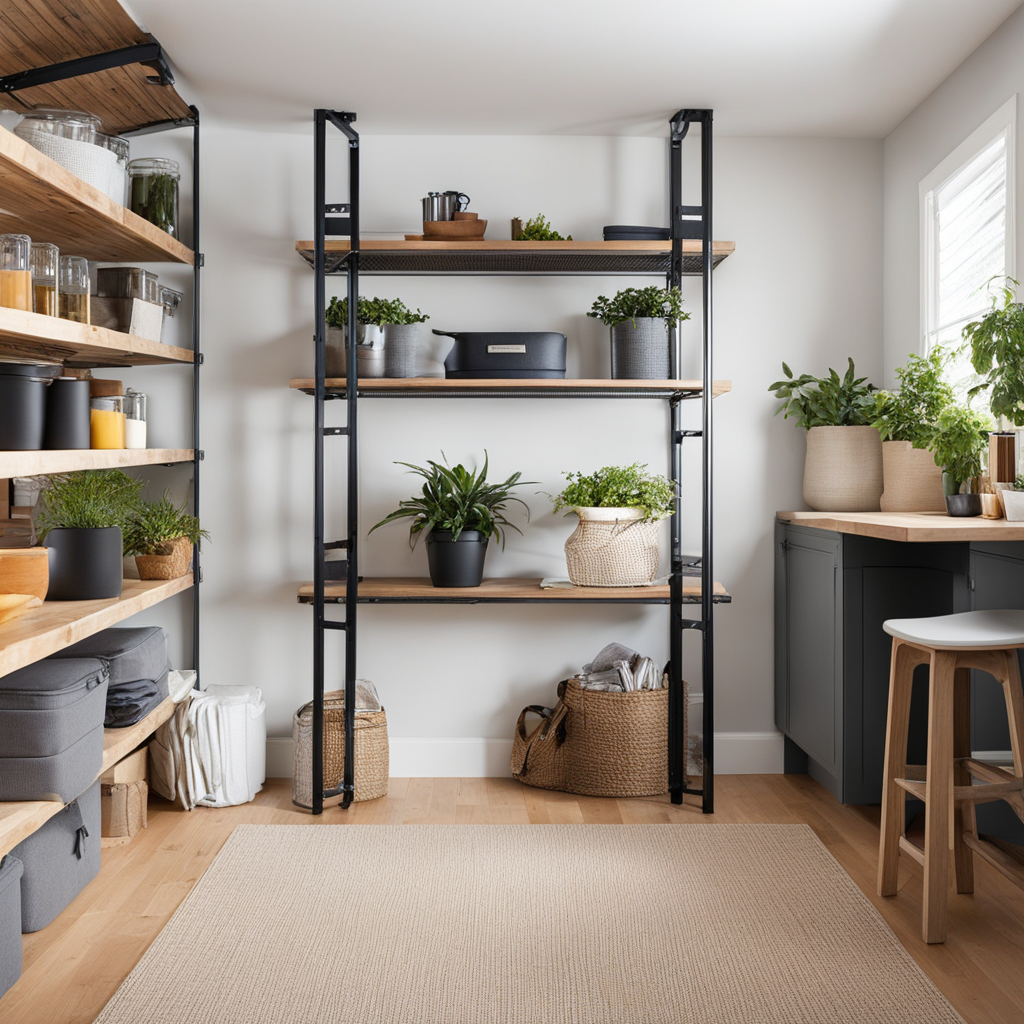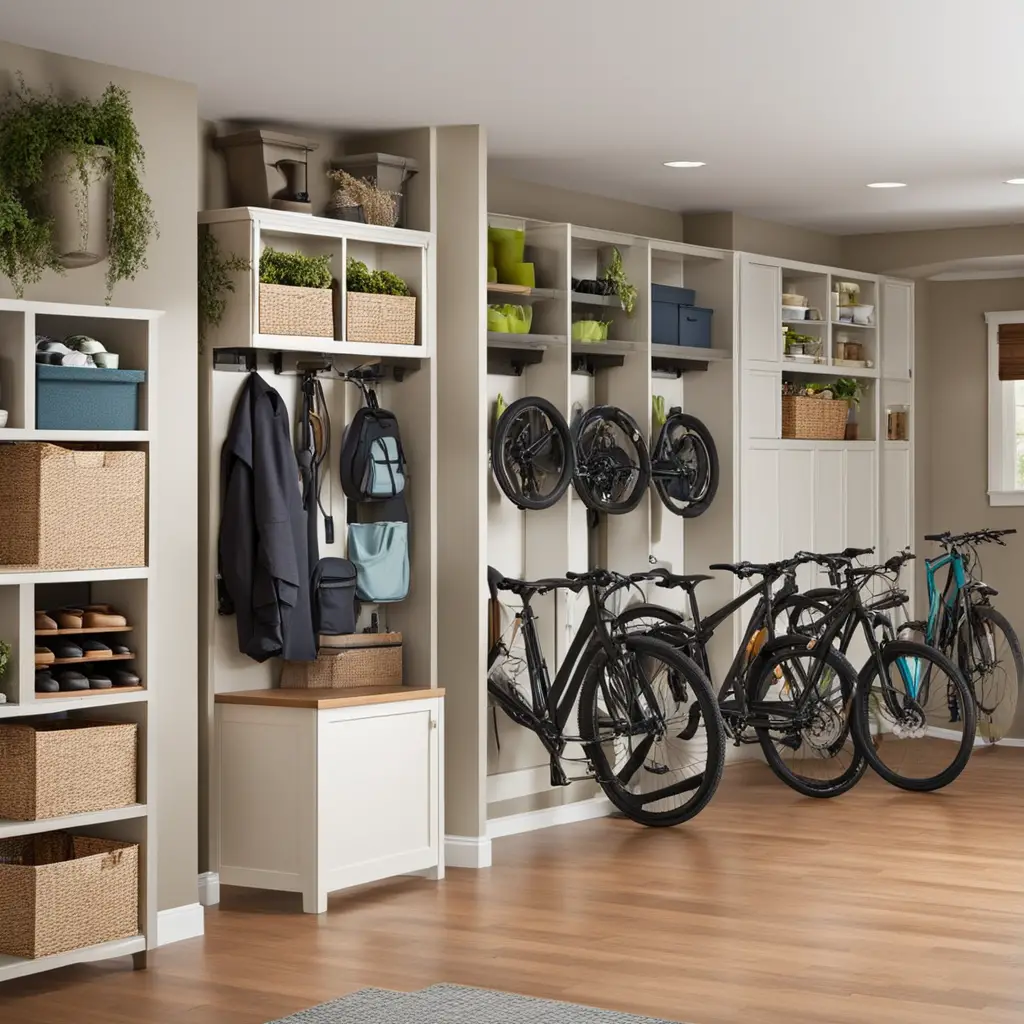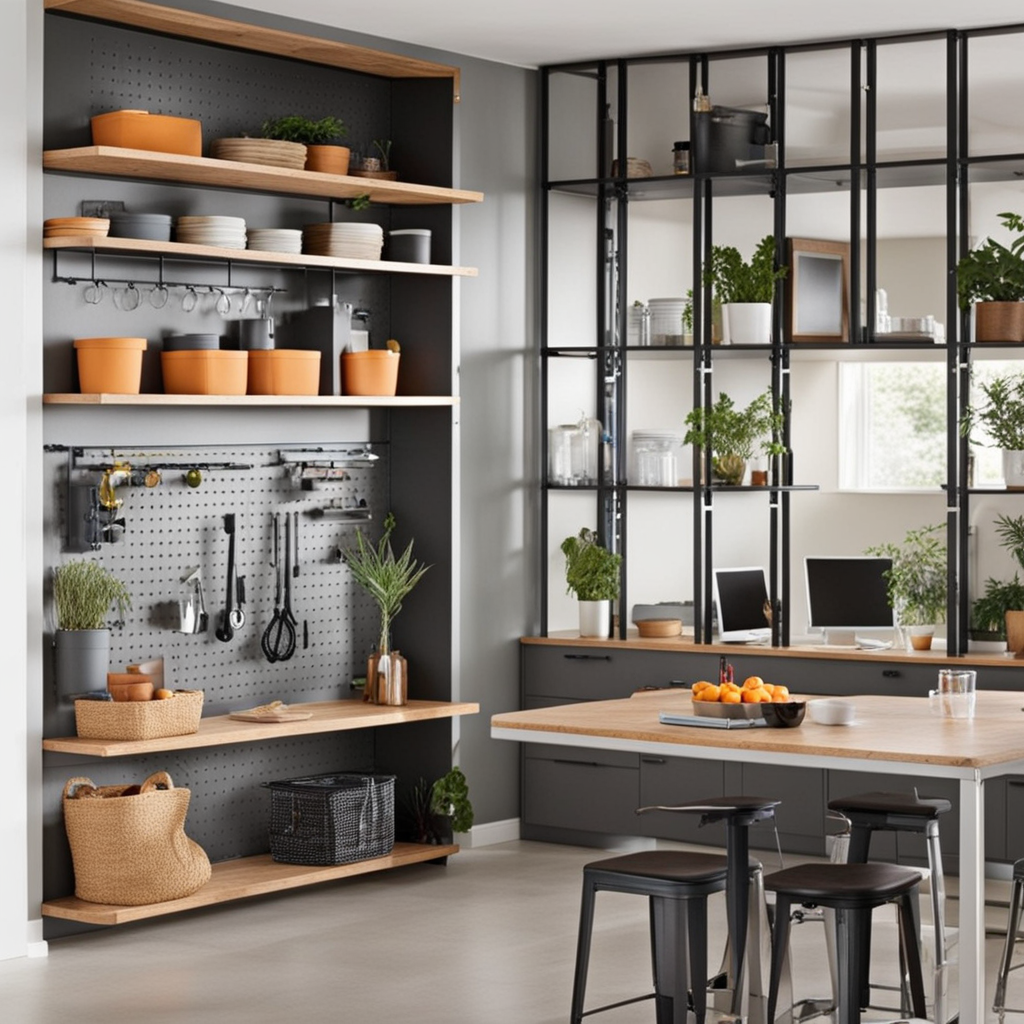Are you looking to make the most of your basement’s vertical space? Proper optimization techniques allow you to transform this often-underutilized area into a functional and beautiful part of your home. In this article, we will share vertical space optimization tips for basement and explore effective strategies and ideas for maximizing the vertical space in your basement. Whether you’re planning to create a cozy entertainment zone, a home office, or an organized storage area, these tips will guide you toward creating a well-utilized and visually appealing basement.
Vertical Space Optimization Tips for Basement
To maximize basement vertical space: Use wall-mounted shelves instead of bulky cabinets, embrace pegboards for versatile organization, and utilize tall units for added storage. Consider ceiling racks, vertical bike storage, and clear stackable bins. Introduce feature walls like climbing setups or gardens, and capitalize on lofted areas if you have high ceilings.
Here are some insightful tips to guide you in optimizing the vertical space in your basement:
Clever Shelving Solutions
When it comes to vertical space optimization, clever shelving solutions are your best friend. Install adjustable shelves or modular storage units that can be customized to fit your specific needs. Utilize wall-mounted shelves to keep items off the floor and create a clutter-free environment. Consider incorporating floating shelves to display decorative items while saving valuable floor space. By implementing innovative shelving solutions, you can efficiently store items and free up space in your basement.
Utilize Vertical Cabinets
Vertical cabinets are excellent space-saving options for basement organization. These cabinets provide ample storage while occupying minimal floor space. Opt for cabinets with adjustable shelves to accommodate items of different sizes. Utilize the full height of your basement walls by installing tall cabinets. This will help you maximize storage capacity and keep your belongings organized and easily accessible.

Create a Multi-Purpose Zone
To make the most of your basement:
- Consider creating a multi-purpose zone.
- Determine the primary functions you want your basement to serve, such as a play area, a home gym, or a relaxation space.
- Divide the basement into different zones using furniture or room dividers.
You can effectively utilize the vertical space by designating specific areas for different activities while maintaining a cohesive and organized layout.
Install Wall-Mounted Desks
If you plan to have a home office in your basement, installing wall-mounted desks is an excellent space-saving solution. These desks provide a functional workspace while leaving the floor area free for other purposes. Choose desks with built-in storage compartments or attach shelves above the desk to keep essential items within reach. Wall-mounted desks are practical and add a sleek and modern touch to your basement.
Opt for Built-In Storage Units
Built-in storage units offer a seamless and integrated look to your basement while providing ample storage space. Custom-built shelves, cabinets, and drawers can be designed to fit the unique dimensions of your basement. This ensures efficient utilization of the available vertical space while complementing the overall aesthetics of the area. Built-in storage units are particularly beneficial if your basement has irregular wall shapes or low ceilings.
Use Overhead Storage Solutions
Take notice of the potential of overhead storage in your basement. Install sturdy ceiling-mounted racks or hanging shelves to store items that are not frequently used. These overhead storage solutions free your basement floor from clutter while providing additional space for seasonal decorations, sports equipment, or rarely accessed items. Use labeled storage bins or containers for easy identification and retrieval.
Incorporate Vertical Wall Decor
Enhance the visual appeal of your basement while utilizing vertical space by incorporating vertical wall decor. Install artwork, mirrors, or decorative wall panels that draw the eyes upward, creating an illusion of height and spaciousness. Choose pieces that complement the overall theme of your basement and add a personal touch to the space. Vertical wall decor enhances aesthetics and makes your basement feel more inviting and visually balanced.
How do you maximize vertical space?
Maximizing vertical space is essential for optimizing the functionality of any area, including basements. Here are some effective strategies to maximize vertical space:
- Utilize Vertical Shelving: Install adjustable shelves or modular storage units that can be customized to fit the vertical dimensions of your space. Vertical shelving allows you to store items efficiently while freeing up floor space.
- Install Overhead Storage: Utilize ceiling-mounted racks or hanging shelves to store items not frequently accessed. This method keeps the floor area clear while providing additional storage space.
- Utilize Wall-Mounted Solutions: Install wall-mounted hooks, pegboards, or racks to hang items such as tools, bicycles, or gardening equipment. This approach saves floor space and frequently keeps used items easily accessible.
- Opt for Tall Furniture: Choose furniture pieces that maximize vertical space. For example, bookcases or cabinets with tall structures provide ample storage without occupying much floor area.
- Use Vertical Organizers: Incorporate vertical organizers such as hanging shoe racks, vertical file holders, or tiered baskets. These organizers can be attached to walls or doors to store small items and keep them within reach.
- Consider Loft Beds or Bunk Beds: Consider using loft beds or bunk beds in bedrooms or guest rooms within the basement. These designs allow you to free up floor space for other purposes while providing sleeping arrangements.
By implementing these strategies, you can effectively maximize vertical space in your basement and create a more organized and functional environment.
How do you raise furniture off the basement floor?
Raising furniture off the basement floor can be beneficial for various reasons, such as protecting it from moisture, improving airflow, or creating additional storage space. Here are some ways to raise furniture off the basement floor:
- Furniture Risers: Furniture risers are small platforms or blocks placed under furniture legs to elevate them. These are readily available in various heights and materials, such as plastic or wood.
- Bed Risers: Bed risers are designed to lift beds off the floor. They usually have a wider base to provide stability and support the weight of the bed frame and mattress.
- Cinder Blocks: Stacking cinder blocks under furniture legs can provide a cost-effective, sturdy solution for raising furniture. Ensure the cinder blocks are stable and placed securely.
- Furniture Pads or Glides: Using higher profile furniture pads or glides can lift furniture off the floor. These pads or glides are typically made of rubber or felt and can be attached to the legs of furniture.
- Storage Platforms or Shelves: Consider using storage platforms or shelves designed explicitly for basement storage. These platforms raise the furniture and provide additional storage space underneath.
When raising furniture off the basement floor, it’s important to ensure stability and safety. Make sure the furniture is well-supported and does not pose a tripping hazard.

What is the best way to increase basement height?
Increasing basement height involves structural modifications and can be complex and costly. Here are a few potential options to consider:
- Underpinning: Underpinning involves excavating and extending the depth of the existing basement foundation. This process allows for increased ceiling height, but it requires the expertise of a professional contractor and may involve reinforcing the existing foundation.
- Digging a New Basement: In some cases, excavating a new basement with a greater ceiling height adjacent to the existing one may be possible. This approach requires careful planning, engineering, and adherence to local building codes.
- Lowering the Basement Floor: Lowering the basement floor is a major construction project that involves digging out the existing floor and creating a deeper foundation. This process can provide additional height but may also require underpinning or reinforcement of the existing foundation.
- Creating a Walkout Basement: If your basement has the potential for a walkout to the exterior, converting it into a walkout basement can provide additional height and natural light. This option may involve excavation and modification of the basement walls and foundation.
It’s crucial to consult a professional contractor or structural engineer to determine the feasibility and cost of increasing basement height. They can assess your situation and guide you on the most suitable method for your basement.
What is benching a basement?
Benching a basement refers to a technique used during basement construction to create a level surface around the perimeter of the basement walls. This technique involves excavating the soil from the basement area while leaving a series of horizontal shelves or benches at various depths. These benches help stabilize the soil, prevent collapse, and increase the basement’s headroom.
Benching is commonly employed when the water table is high, or the soil conditions require additional support to prevent basement walls from buckling or collapsing. The benches are a retaining structure that holds the soil back and reduces the lateral pressure on the basement walls.
Benching is typically used with waterproofing measures to ensure a dry and stable basement environment. It provides a practical solution for maximizing usable space and maintaining the structural integrity of the basement.
Are there any specific types of shelving that work best in a basement?
When choosing to shelve for a basement, it’s important to consider the specific requirements and challenges of the environment. Here are a few types of shelving that work well in basements:
- Wire Shelving: Wire shelving is a popular basement choice due to its durability, ventilation properties, and moisture resistance. It allows for airflow, preventing condensation buildup and reducing the risk of mold or mildew growth.
- Plastic Shelving: These units are lightweight, easy to clean, and moisture-resistant. They are an affordable and versatile option for storing items in basements.
- Metal Shelving: Metal shelving provides robust support and can handle heavy loads. It is particularly suitable for storing large or bulky items in the basement.
- Adjustable Shelving: Opt for adjustable shelving units that customize the spacing between shelves according to your storage needs. This flexibility enables you to accommodate items of different sizes.
- Wall-Mounted Shelving: Wall-mounted shelves are an excellent choice for maximizing vertical space in basements. They keep items off the floor and create a more organized and visually appealing storage solution.
When selecting shelving for your basement, consider factors such as durability, resistance to moisture, ease of maintenance, and the specific items you plan to store. Choose shelving that suits your needs and complements the overall aesthetics of your basement.
What are some DIY solutions for optimizing vertical space in a basement?
If you’re looking for DIY solutions to optimize vertical space in your basement, consider the following ideas:
- Pegboards and Hooks: Install a pegboard on the wall and attach hooks to hang tools, accessories, or small items. This helps keep your basement organized and items easily accessible.
- Stackable Bins or Boxes: Use stackable storage bins or boxes to maximize vertical space. Label each bin for easy identification and stack them securely to maximize storage capacity.
- Tension Rods: Install tension rods between walls to create hanging space for items such as cleaning supplies, fabric rolls, or lightweight equipment. This allows you to utilize vertical space that would otherwise be unused.
- Vertical Shoe Racks: Install a vertical shoe rack on the back of a door or wall to store and organize shoes. This frees up floor space and keeps your footwear easily accessible.
- Floating Shelves: Install floating shelves on the walls to display decorative items or store books. Floating shelves not only provide storage but also add a visually appealing element to your basement.
- Hanging Baskets: Hang baskets from the ceiling or wall-mounted hooks to store items like sports equipment, gardening tools, or craft supplies. This helps keep the floor area clear and maximizes storage options.
Remember to assess the weight-bearing capacity of any DIY solution and ensure that it is securely installed. DIY projects should prioritize safety and be tailored to your needs and basement layout.

How do I determine the best layout for my basement storage needs?
Determining the best layout for your basement storage needs requires careful planning and consideration of your requirements. Here’s a step-by-step process to help you:
- Evaluate Your Storage Needs: Begin by assessing the types of items you need to store in your basement. Categorize them based on the frequency of use, size, and specific storage requirements.
- Measure Your Basement: Take accurate measurements of your basement space, including the dimensions of walls, windows, doors, and other architectural features. Consider any obstructions or irregularities that may impact the layout.
- Consider Functionality: Determine how you want to use your basement space. Whether it’s for storage, a home office, a play area, or a combination of functions, consider the activities that will take place in the basement and how storage fits into the overall layout.
- Plan Zones and Traffic Flow: Divide your basement into functional zones based on your needs and available space. Create designated areas for storage, specific activities, or furniture placement. Consider the flow of movement between these zones to ensure accessibility and functionality.
- Use Vertical Space: Take advantage of vertical space by incorporating wall-mounted shelving, hooks, or overhead storage solutions. This allows you to optimize storage while keeping the floor area clear.
- Sketch the Layout: Create a rough sketch or use design software to visualize different layout options. Experiment with various arrangements until you find one that maximizes storage capacity and suits your needs.
- Flexibility and Accessibility: Ensure your chosen layout allows easy access to stored items. Consider using adjustable shelving, labeled bins, or pull-out drawers to facilitate organization and retrieval.
- Safety Considerations: Prioritize safety in your layout by avoiding overcrowding or blocking access to utilities, windows, or doors. Leave clear pathways and ensure that heavy or fragile items are stored securely.
Remember that the layout of your basement storage should be adaptable to accommodate future changes or additional storage needs. Regularly reassess and reorganize to maintain an efficient and functional space.
Conclusion
Optimizing the vertical space in your basement can unlock its true potential, transforming it into a functional and aesthetically pleasing area. You can make the most of every inch in your basement by implementing clever shelving solutions, utilizing vertical cabinets, creating multi-purpose zones, and incorporating wall-mounted desks and built-in storage units.
Use overhead storage solutions and enhance the visual appeal with vertical wall decor. With these tips, your basement will become a space that seamlessly combines functionality and beauty.
Maximizing vertical space in your basement is crucial for creating a functional and visually appealing area. You can optimize every inch of your basement by implementing clever shelving solutions, utilizing vertical cabinets, creating multi-purpose zones, and incorporating wall-mounted desks and built-in storage units. Overhead storage solutions and vertical wall decor add the finishing touches to make your basement truly remarkable.

